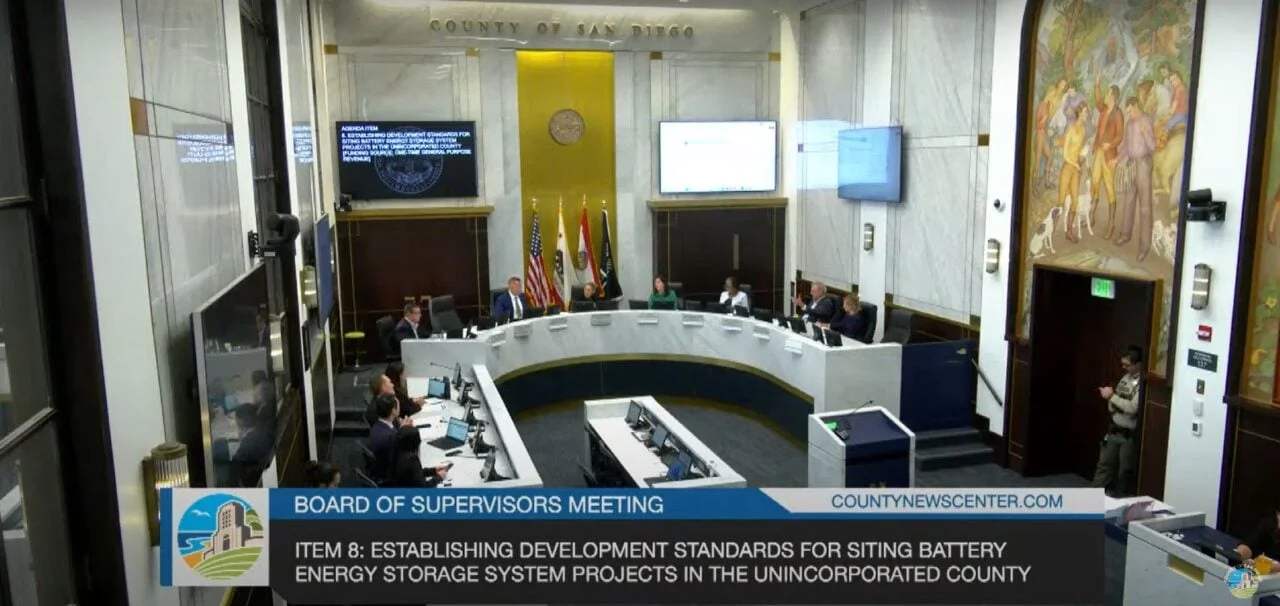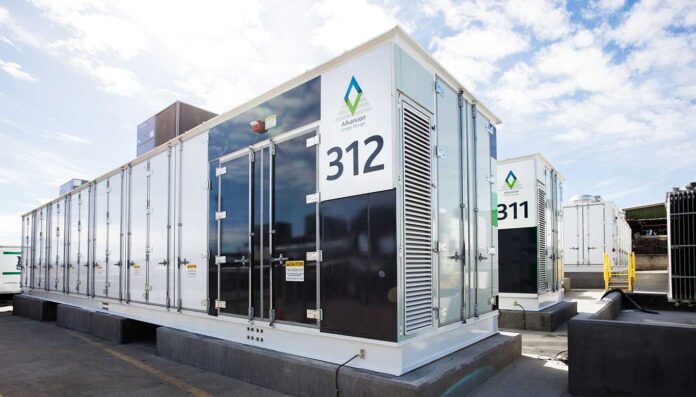Battery Energy Storage Systems Project | Safety Standards for BESS in San Diego County
Summary
1. San Diego County is considering new safety standards for battery energy storage systems (BESS) following recent fires at two facilities:
- A fire at Terra-Gen's Valley Center BESS in September 2023
- A more severe fire at Rev Renewable's Gateway Energy Storage facility in May 2024, which lasted for nearly two weeks
2. The County Board of Supervisors voted on July 17, 2024, to develop new standards for BESS facilities, with potential measures including:
- Restricting locations away from residential areas
- Incentivizing placement in industrial zones
- Implementing stricter safety protocols
3. The development of these standards is expected to cost up to $1.25 million.
4. There are currently 12 active BESS applications in various stages of approval in San Diego County.
5. The board is considering several interim measures while developing the new standards, including:
- A possible temporary moratorium on new BESS applications
- Mandatory board review of all new BESS projects
- Interim standards within six months
6. The county is organizing a public meeting on August 15, 2024, to gather input on the BESS project and discuss safety concerns.
7. Similar concerns are being addressed elsewhere, such as in Wilson, New York, where a 12-month moratorium on new BESS permits was enacted while officials draft new local laws for battery siting.
8. These actions reflect growing concerns about the safety of large-scale battery storage facilities and the need for updated regulations to address potential risks.
BESS Standards
1. Siting and Location:
- Establish minimum distances from residential areas, schools, hospitals, and other sensitive locations
- Incentivize placement in industrial zones and near existing utility infrastructure
- Consider topography and natural barriers for additional safety
2. Design and Engineering:
- Require advanced fire suppression systems specifically designed for lithium-ion battery fires
- Mandate robust thermal management and monitoring systems
- Establish minimum separation distances between battery units
- Implement strict electrical safety standards
3. Emergency Response Planning:
- Require detailed, site-specific emergency response plans
- Mandate regular training exercises with local fire departments
- Establish protocols for extended firefighting operations (given the 15-day duration of the Gateway fire)
- Require on-site emergency equipment and materials specific to battery fires
4. Monitoring and Early Warning Systems:
- Implement 24/7 monitoring of battery conditions (temperature, voltage, etc.)
- Require early detection systems for thermal runaway and gas emissions
- Establish protocols for automatic shutdown in case of anomalies
5. Maintenance and Inspection:
- Set frequent, mandatory inspection schedules
- Require regular testing and maintenance of all safety systems
- Mandate record-keeping and reporting of all maintenance activities
6. Community Safety and Communication:
- Establish clear protocols for notifying nearby residents in case of incidents
- Require regular community outreach and education about the facility and its safety measures
- Implement visible safety signage and information around the facility
7. Environmental Protection:
- Require containment systems to prevent chemical leaks into soil or water sources
- Mandate air quality monitoring systems
8. Capacity and Scale Limitations:
- Consider setting maximum energy storage capacities based on location and proximity to populated areas
9. Third-Party Verification:
- Require independent safety audits and risk assessments
- Mandate third-party testing and certification of key safety systems
10. Decommissioning and Disposal:
- Establish clear protocols for safe decommissioning of facilities
- Require proper disposal or recycling plans for batteries and associated materials
11. Ongoing Review and Updates:
- Establish a mechanism for regular review and update of safety standards as technology evolves
- Require facilities to upgrade safety measures as new standards are developed
12. Insurance and Liability:
- Mandate specific insurance coverage for potential incidents
- Establish clear liability frameworks for operators
By implementing comprehensive standards that address these areas, San Diego County can significantly enhance the safety of BESS facilities while still allowing for their development and operation. These standards should be developed in consultation with industry experts, fire safety professionals, and community stakeholders to ensure they are both effective and practical.
Battery Energy Storage Systems Project | North County Daily Star
We want to hear from you! The County of San Diego Planning & Development Services (PDS) invites you to attend a public meeting to share your thoughts on the Battery Energy Storage Systems project. A Battery Energy Storage System is a technology designed to store and manage energy for later use. It typically uses rechargeable batteries to store energy from various sources, such as the electrical grid, renewable energy sources like solar or wind power, or other power generation methods.
On July 17, 2024, the County Board of Supervisors asked staff to work with applicants to ensure that these facilities are taking all possible safety precautions to operate. The purpose of this public meeting will be to provide information on the Board direction, the different phases of the project, and opportunities for future outreach and engagement. PDS is hosting this virtual public meeting to receive your input on August 15, 2024, at 6:00 PM (registration link provided below).
Disability-related accommodations necessary to facilitate meeting participation, language interpretation, including American Sign Language, and written materials in alternative languages and formats are available upon request. Please submit your request at least 72 hours in advance of event to: Michael Madrid at PDS.LongRangePlanning@sdcounty.ca.gov
Please register in advance for the public meeting using the link provided below.
When: Thursday, August 15, 2024, 6:00 PM
Where: Virtual Meeting https://sdcounty-ca-gov.zoom.us/meeting/register/tZAkcuuprzMpHdc3wYvVKMMdZ4FaVAbM5qYT
Please help us spread the word – share this message with your friends and colleagues!
For more information about the Project, please visit this link: Battery Energy Storage Systems (sandiegocounty.gov)
To receive updates on the Project, please subscribe to the Battery Energy Storage Systems email list at: Battery Energy Storage Systems (sandiegocounty.gov)
If you have any questions, please contact Michael Madrid at PDS.LongRangePlanning@sdcounty.ca.gov or at the following phone number:
(858) 505-6677.
California’s San Diego County votes to adopt BESS standards following recent battery fires - Pro Bid Energy

Fires at two of three approved BESS facilities in San Diego County
Jim Desmond’s concerns surrounding battery storage technology stem from recent high-profile fires at two of three BESS facilities green-lit for construction by San Diego County officials.
As reported in Energy-Storage.News, a battery unit at Terra-Gen’s 140MW/560MWh Valley Center BESS caught fire on 18 September 2023, causing a quarter-mile evacuation area that lasted until later in the evening, when the fire had been contained.
This incident was then followed by a much more significant fire at Rev Renewable’s Gateway Energy Storage facility that first ignited on 15 May 2024. An evacuation order was deployed by the California Department of Forestry and Fire Protection (CalFire) for San Diego that lasted until 28 May, while it worked to contain the fire.
In daily statements posted on X (formerly Twitter), CalFire reported several instances of thermal runaway at the Gateway site, deploying up to 40 fire personnel during the height of activity. The causes of both fires are currently unknown amidst ongoing investigations.
The third BESS facility approved by San Diego County officials is San Diego Gas & Electric’s (SDG&E’s) Fallbrook energy storage facility that was brought online in 2022. Ownership of the 40MW BESS was transferred from AES Corporation to the California public investor-owned utility (IOU) upon completion of the project under a build-own-transfer agreement.
Dozen active BESS applications in San Diego County
During the meeting, Desmond stated that there were currently 12 active BESS applications with San Diego’s Planning and Development Services department at various stages of the approval process, including another development from AES known as the Seguro energy storage project.
It was recently reported by local news outlet Coast News that the Palomar Health Administration had denied an easement which would have allowed the 320MW/1,280MWh BESS to connect to SDG&E’s Escondido substation via land owned by the Palomar Medical Center.
According to an AES website, the project was initially envisioned as having 400MW/1,600MWh of storage capacity but had been “reduced due to stakeholder and community feedback”.
San Diego BESS standards could incentivise use of industrial zones
During the meeting, Desmond explained that the development standards should stop developers locating BESS facilities in residential areas but also incentivise developers to locate facilities within industrial zones.
He also requested that at the next meeting, the board instate a temporary 45-day moratorium (with up to two 1-year extensions) on the approval of any new BESS facilities until the new standards had been adopted.
The development of BESS standards is expected to cost San Diego County up to US$1.25 million.
‘Really big problem’
The Vice Chair of the San Diego County Board of Supervisors Terra Lawson-Remer expressed concerns surrounding a potential two-year moratorium on the installation of new BESS facilities.
Lawson-Remer, also on the Board of Directors for California Community Choice Aggregator (CCA) energy supplier San Diego Community Power (SDCP), said that although she wanted to “move expeditiously” to create the new standards, it was her understanding that it could take up to two years or more for them to be developed, and that the county would have a “really big problem with local energy needs” if no new sites could be built during this period.
Instead of instating a blanket moratorium, the board passed a motion agreeing to adopt new standards but also decided that at the next meeting it would discuss several potential stopgap measures to incentivise BESS safety whilst the standards were being developed.
The board agreed that the discussion points should include a temporary moratorium on new BESS applications, mandatory board review of all new BESS projects and interim standards within six months.
Watch the 17 July 2024 Board of Supervisors meeting below, discussion of Item #8 on establishing development standards for siting of BESS begins at 1 hour 20 minutes.
12-month moratorium for New York town
Elsewhere in the US, the Town of Wilson in Niagara County, New York recently enacted a 12-month moratorium on the processing of any new permits for projects with BESS facilities, whilst town officials drafted new local laws for battery siting.
At the Wednesday 17 July 2024 meeting, town supervisor Tony Evans said that the town would “take their time” drafting the new laws and would extend the moratorium if required.
Like California, there have been several high-profile fires at BESS facilities within the state of New York, including incidents at three separate facilities which occurred last year during May and July.
This led to the formation of the New York State Inter-Agency Fire Safety Working Group, which released its first set of recommended changes to the New York fire code during the first quarter of this year, as reported by Energy-Storage.News.




Comments
Post a Comment